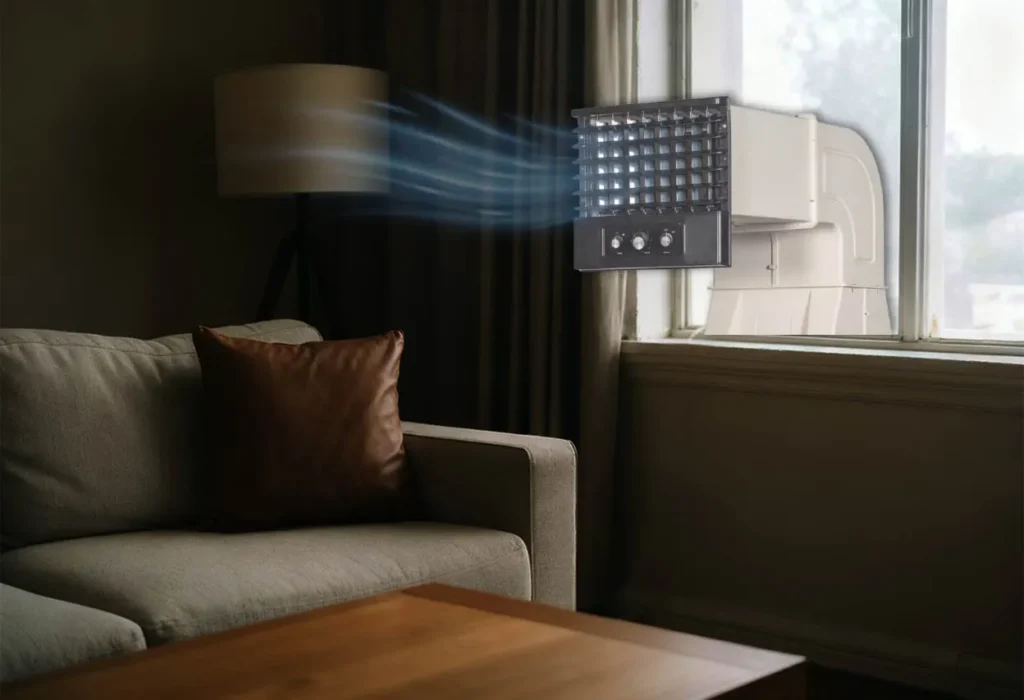With every passing summer, Indian homes and offices feel the pressure of rising temperatures, leading many people to look for cooling solutions that are both budget-friendly and practical. Not everyone has the space or the need for bulky desert coolers or high-power air conditioners, which has opened the door for compact and efficient alternatives. This is where window coolers are gaining attention. Their ability to deliver strong cooling without occupying floor space makes them an ideal choice for small apartments, bedrooms, and office cabins. For first-time buyers trying to understand their options, knowing what a window cooler is and how it functions can make it much easier to choose the right cooling partner.
What Is a Window Cooler?
A window cooler, also known as a window air cooler, is an evaporative cooler designed to be mounted in a window frame, similar to a window air conditioner. Unlike large portable coolers that sit on the floor, window coolers stay fixed in place and pull hot air from outside, cool it using water-saturated pads, and circulate fresh, cool air inside the room.
Window coolers differ significantly from other cooler types. Desert coolers are large units meant for big halls or outdoor areas and have very high airflow. Tower coolers are slim, modern, and portable, designed for living rooms and bedrooms. Personal coolers are compact units ideal for small spaces or individual use. Window coolers fall in between they provide stronger cooling than personal coolers while being more space-efficient and affordable than desert coolers. This makes them ideal for apartments and small offices where floor space is limited but effective cooling is required.
How Window Coolers Work
Window coolers operate on the principle of evaporative cooling. The cooler pulls warm air from outside through cooling pads that are kept constantly wet by a water pump. As the warm air passes through these pads, water evaporates and absorbs heat from the air, turning it into cool, refreshing airflow. The fan then pushes this cool air directly into the room.
Because the cooler sits in a window opening, it naturally draws in fresh outdoor air and expels humid indoor air, maintaining a continuous ventilation cycle. This improves air quality and ensures the room never becomes stuffy. Proper placement is key to performance a tightly fitted window installation ensures maximum cooling and prevents the cooler from drawing back humid air from inside.
Benefits of Using a Window Cooler
One of the biggest advantages of a window cooler is its space-saving design. Since the cooler is mounted on the window frame, it does not occupy floor space and keeps your room layout free for furniture and movement. This is especially beneficial in smaller homes and city apartments where every inch matters.
Window coolers also deliver strong airflow, often more powerful than personal coolers. Because they draw air from the outdoors and push it inside with force, they cool rooms faster and maintain consistent airflow even in warmer environments. This makes them suitable for regions that experience dry or extremely hot summers.
Another major benefit is energy efficiency. Window coolers consume far less power than air conditioners and are more economical for long-term daily use. They use water instead of chemical refrigerants, making them safer and more environmentally friendly.
Fresh air ventilation is another highlight of window coolers. While air conditioners recirculate the same indoor air, window coolers continuously bring in clean outdoor air, improving oxygen levels and preventing the room from feeling confined. Because of their cooling strength and compact size, window coolers are ideal for bedrooms, small halls, office cabins, study rooms, and urban apartments. They offer a cooling solution that fits well in areas where larger coolers cannot be placed.
Where Window Coolers Work Best
Window coolers perform exceptionally well in dry and semi-humid climates where evaporative cooling is most effective. They are perfect for small to medium-sized rooms, ideally ranging from 100 sq. ft. to 300 sq. ft. Depending on the airflow capacity (CFM) and fan size, certain models can cool larger spaces as well.
Homes with limited floor space, such as apartments and compact houses, benefit greatly from window coolers since the installation does not obstruct room movement. They also work well in small offices, retail shops, and manager cabins where consistent airflow is needed but the space is not large enough for a desert cooler.
Window coolers are also preferred in rental homes because they offer effective cooling without requiring permanent structural changes. As long as there is a suitable window opening, installation is quick and hassle-free.
Things to Consider Before Buying a Window Cooler
Before purchasing a window cooler, it’s important to consider several key factors that determine performance and suitability for your space.
Start with cooling capacity, which is measured in CFM (Cubic Feet per Minute). Higher CFM means more airflow and better cooling for larger rooms. Tank size also matters, as it determines how long the cooler can operate before needing a refill. A medium tank (20–40 liters) works well for bedrooms, while larger tanks are ideal for extended use.
Fan type plays a big role too. Blower-type fans deliver focused airflow suitable for bedrooms and offices, while fan-type models offer wider, more natural airflow. Installation space is another essential factor the cooler must fit comfortably into the window without leaving gaps.
Power consumption and noise levels are equally important. Most window coolers are energy-efficient, but models with BLDC motors provide even better performance with lower electricity use. Quiet operation is important for bedrooms and study rooms where noise can disrupt sleep or concentration.
Maintenance Guide for First-Time Users
Window coolers are easy to maintain, but regular care ensures long-lasting performance. Cleaning the cooling pads at least once every two weeks during peak season helps maintain airflow and cooling efficiency. Pads should be replaced when they show signs of wear or reduced absorption.
Tank hygiene is equally important. Clean the water tank regularly to prevent sediment buildup or odour. Before each summer season, perform a thorough check of the pump, motor, and wiring for safety. Proper placement also matters ensure the cooler is snugly fitted into the window opening for optimal performance.
Popular Window Cooler Brands in India
Several well-known Indian brands manufacture high-quality window coolers suited for various needs. Raj Cooling Systems is recognized for its durable builds, strong airflow, and reliable cooling performance. Their models are well-suited for both homes and small commercial spaces.
Brands like Symphony, Bajaj, and Crompton also offer efficient window coolers designed for compact rooms and modern apartments. Symphony models often focus on innovation and performance, while Bajaj and Crompton provide budget-friendly options with dependable quality. Choosing a reputable brand ensures better after-sales support, spare part availability, and long-term durability.
Conclusion
For first-time buyers seeking an affordable, compact, and effective cooling solution, a window cooler offers the perfect balance of performance and convenience. Its ability to provide strong airflow, fresh ventilation, and efficient cooling without occupying floor space makes it an ideal choice for small homes and offices. With proper installation and basic maintenance, a window cooler can deliver reliable comfort throughout the summer. Whether you’re upgrading from a personal cooler or looking for a budget-friendly alternative to air conditioning, window coolers remain one of the most practical and valuable cooling options for Indian households.

